

Home of FHEM. RF24Network for Wireless Sensor Networking. RF24Network is a network layer for Nordic nRF24L01+ radios running on Arduino-compatible hardware.
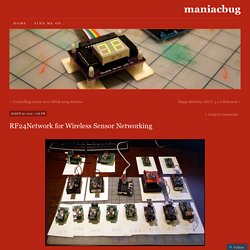
It’s goal is to have an alternative to Xbee radios for communication between Arduino units. It provides a host address space and message routing for up to 6,000 nodes. The layer forms the background of a capable and scalable Wireless Sensor Network system. At the same time, it makes communication between even two nodes very simple. Today, I managed to get 17 nodes running on a single network. Hardware. TinyUSBboard. Arduino compatible without extra programmer and/or FTDI chip (USB<->serial) needed!
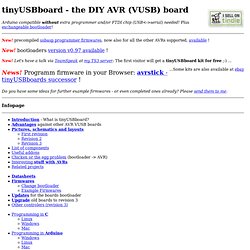
Plus exchangeable bootloader! New! Precompiled usbasp programmer firmwares, now also for all the other AVRs supported, available ! New! [Arduino] DIY (stupid and cheap) Plants Irrigator. It’s a burning summer in Florence and I needed a solution to watering my little plants I have around the house.
![[Arduino] DIY (stupid and cheap) Plants Irrigator](http://cdn.pearltrees.com/s/pic/th/arduino-irrigator-lenotta-69238992)
Of course I had a look at some shops for a ready solution, but where is the joy of experimenting with an arduino? RF24Network: Network Layer for RF24 Radios. This class implements an OSI Network Layer using nRF24L01(+) radios driven by the RF24 library.
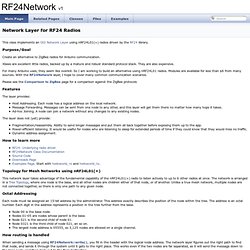
Purpose/Goal. Getting Started with nRF24L01+ on Arduino. Nordic’s nRF24L01+ 2.4GHz RF radios are a great way to communicate wirelessly between Arduino’s.
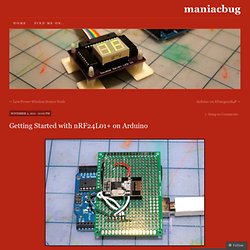
Node-RED. Home automation in Node.js with Raspberry PI and Arduino. Some examples using the Arduino plugin.
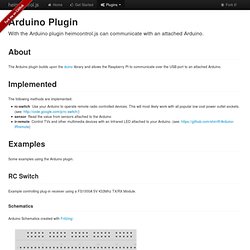
Interface Board Kit. The Quick2Wire® Interface Board Kit gives you safe and easy access to all the features on your Raspberry Pi’s expansion header.
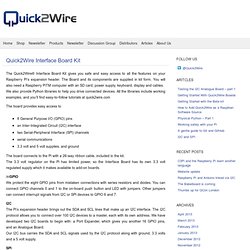
The Board and its components are supplied in kit form. You will also need a Raspberry PiTM computer with an SD card, power supply, keyboard, display and cables. iHome - Smart Home Automation in Thailand, Vietnam, Singapore, Malaysia, and throughout Asia. OpenHAB 1.0: Offene Plattform für die Heimautomation. Freedomotic-android-client - An Android client for Freedomotic. The first Android remote client to use with Freedomotic: a mashup oriented building and home automation framework.
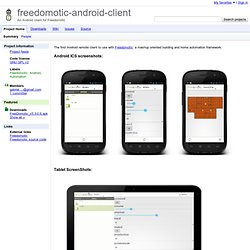
Android ICS screenshots: Tablet ScreenShots: 1) Clone the project from Source 2) Install and configure Android SDK, Eclipse and ADT. See Installing the ADT plugin 3) Load the cloned project in Eclipse. Data mashup building automation framework. 2.0 How To - Z-Wave with Razberry. Since ZWay 2.0.2 clients like OpenRemote need to authenticate with ZWay on the Raspberry Pi.

The description here does not yet take that into acoount. A quick work-around is to allow anonymous (unsecure!) Access to Zway. You can achieve this in ZWay Smarthome as follows Create a room named devices, and assign all ZWay devices to that room Create a user named anonymous with role anonymous Edit user anonymous and allow access to room devices (If you already assigned devices to rooms, you have to give user anonymous access to all those rooms) Your OpenRemote client should have unrestricted access to ZWay now. Instructions for proper authentication will follow here shortly Unfortunately, ZWay does not comply with the IETF Authentication standard. Competence level Some acquaintance with the Raspberry Pi. Raspberry Pi and RaZberry as Z-Wave controller - Digits Domotica Blog. Today the first Raspberry Pi (RPi) arrived.
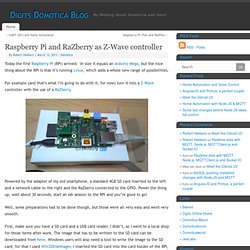
In size it equals an Arduino Mega, but the nice thing about the RPi is that it’s running Linux, which adds a whole new range of possibilities. For example (and that’s what I’m going to do with it, for now) turn it into a Z-Wave controller with the use of a RaZberry. Powered by the adapter of my old smartphone, a standard 4GB SD card inserted to the left and a network cable to the right and the RaZberry connected to the GPIO. Power the thing up, wait about 30 seconds, start an ssh session to the RPi and you’re good to go! Open Home Automation. Looking for a cheap IEEE 802.15.4 transceiver? I was already thinking about hacking the Philips Hue lighting adapter. But there is a cheap (<10 Euro) adapter available from Microchip. Note, that this implements pure IEEE802.15.4, not the whole ZigBee protocol stack. Nrf24l01+ for commercial home automation ? Hack your own radio transmitter. Posted on 3 Apr 2013 at 12:02 Paul Ockenden gives a primer on how to use a short-distance radio to beam data between devices My last little exploration of the RF spectrum was actually only part one of a two-parter that continues here.
We’ve done the theory test; now it’s time to get our hands dirty with the more practical side of things. I’ll be showing you how to hack together a simple and cheap system for short-range radio data communication. We’re going to use one of the licence-free bands within the RF spectrum, and the frequencies you can use will vary depending on where in the world you live. The ITU splits the world into three regions, Region 1 being Europe, Africa, the western side of the Middle East and what we used to call the Soviet Union. We’ve done the theory test; now it’s time to get our hands dirty with the more practical side of things The licence-free bands vary by region, and there are a few national variations as well.
Different board. Heimcontrol.js - Home automation in Node.js with Raspberry PI and Arduino. Z-Wave. Vera. How Can I Get Started with Home Automation? Nwazet Pecan Pi Relays. The Pecan Pi Relays kit is designed to be interfaced with the Raspberry Pi's GPIO connector and features six normally open relays, each capable of switching up to 16A @ 250VAC. The relays are rated for at least 1.5 million cycles. The Pecan Pi Relays kit requires an external power supply capable of providing ~800mA @ 5V, such as the Nwazet Pi Power Supply, since the Raspberry Pi cannot supply enough current through its GPIO connector. The relay board can optionally power the Raspberry Pi. The kit is designed so that other boards can be chained through it.
Home automation project. Ten essential Raspberry Pi projects. Ten projects for the Raspberry Pi that range from educational to fun via highly useful. This is by no means an attempt at a definitive list and the term essential is somewhat subjective, but if you're stuck for something new to do with your Raspberry Pi there may be some ideas here! Smartenit adds the sweetness of Linux Home Automation to Raspberry Pi making it HomAidPi à la mode.
HomAidPi-Press PRLog (Press Release) - Jul. 26, 2012 - San Juan Capistrano, CA Smartenit, Inc. There is nothing as tasty as homemade raspberry pie in the summer, and the ice cream on top makes it even more delicious, especially when it’s free. Smartenit®, a home and building automation solutions provider, has added the popular Raspberry Pi® board to their repertoire of Linux platforms that run its XML-socket based automation package. The firmware enables the RPi to become a fully-featured and sophisticated automation gateway that manages large home/building automation networks based on ZigBee®, INSTEON® and X10® protocols. “HomAidPi” in a Raspbian equipped RPi plus one of several USB automation interfaces available from Smartenit and other suppliers, provide access to a large ecosystem of automation devices that include lighting, HVAC, irrigation, appliance control, energy management, water management to name a few.